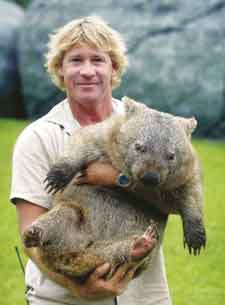Magazine
Why I Won't Salute Steve Irwin

He was an Australian, but his popularity was admittedly universal. His Crocodile Hunter series of animal documentaries attracted a regular combined viewership of more than 200-million worldwide, testifying to his global appeal.
Steve Irwin was killed in September off Australia’s northeast coast after he was hit by the serrated barb from a sting-ray’s tail during a diving expedition for a television shoot. He was apparently grappling with the sting-ray, which reacted in self-defence. The barb pierced his chest and stilled his heart. A most painful death, doctors said. Was I saddened? Of course, I was. Any death saddens me. As an animal lover, will I salute Steve Irwin’s memory? Sorry, I will not. His bio-data would suggest that 44-year-old Irwin was a first-rate naturalist and wild-life crusader, even a global ambassador of conservation. In his television interviews too, he made the correct noises. His mission, he proclaimed, was to make wild-life environs palpable at close quarters, not something to be admired like a pretty picture postcard through a long-range television lens. In his video documentaries however – and let’s not forget that that’s where he earned his reputation and where his legacy will ultimately endure – he came across as anything but a committed environmentalist. He trespassed into the habitats of all kinds of animals, manhandled and bullied them with a repulsive gusto, and then topped it all by startling the distressed creatures with shrieking endearments: “Crikey, my beauty, aren’t you gorgeous?” What was Irwin really aiming at? A closer personal equation with wild and dangerous creatures? Or higher television ratings? With his chunky torso and blonde hair, his tight-fitting khaki shirt and shorts, a permanent glint in those beady eyes, and sporting an assortment of gashes from his daily encounters with danger, Steve was a rough-cut backwoods avatar of another famous Australian – cricketer Shane Warne. The comparison was most telling in their aggressive and gregarious demeanour, the barely concealed violence of their public performances, and the equally obvious glee with which they went about their chosen vocations.
But while such aggression might be admirable on a cricket field, it was strangely out of place in a zoo or even in a rainforest. Simply because it came to symbolize the arrogant White Man’s unholy ambition to dominate – even annihilate, if domination is not possible – Nature and his fellow-creatures with a crafty, wily, and therefore technologically superior skill. Irwin may have tried hard to be an animal “lover” by getting physically close – even intimate – with the animals. But he succeeded merely in hreflecting the narcissistic and colonial attitude of his ancestors. If his Caucasian forefathers colonized and subjugated the dark-skinned natives of the American, African, Asian and Australian continents, Steve Irwin had set his sights on the entire animal kingdom. Crocodiles – the more lethal and carnivorous, the better – were his self-confessed favorites. In an act that was amazing television spectacle, but dubious parenting practice, he dangled his month-old baby in one hand while feeding chickens to a hungry crocodile at hand-shaking distance in Australia Zoo. Irwin later explained to his horrified critics that he was only training the toddler to overcome its fear of crocodiles! It is rightly said that a society can be judged by the way it treats its children and its animals. Television documentaries showing beefy control-freaks grappling routinely with animals convey the message – to impressionable growing kids, in particular – that those animals are objects to be toyed and trifled with for our entertainment: a four-legged variation of a WWF bout! Who will rein in these control-freaks? The American Indians as well as the Australian aborigines were nearly wiped out when they resisted the “pale-faced” intruders and their ruthless ways. Would the good old Indian philosophy of ahimsa or non-violence, with its innate reverence for life, provide the answer? It’s a clear pointer to the animistic origins of Hinduism that we still worship snakes and elephant-headed gods, and have designated an animal or bird as a vehicle for each mythological deity, thus ensuring that they too are deified by association. Several of the names we give our newborns – Nagaraj (snake), Ganesh (elephant), Hansraj (swan), Ashwin (horse), Sharang (deer), Sheroo (tiger) – and even family names like Singh and Popat speak of our traditional regard for the animal kingdom. Contrast this with reports of Steve Irwin’s fans mourning his death. Several of them went on a revenge-killing spree leaving a trail of dead sting-rays. For a man who is said to have lived for animals, there could be no greater failure of his life-mission. |


